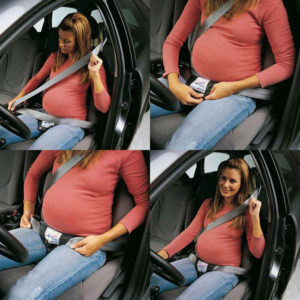During pregnancy, the entire body of the expectant mother is tuned so that all organs are focused on bearing the fetus, so the reaction speed is reduced. Often pregnant women are distracted, unable to concentrate. It is clear that during this period a woman should be especially careful while driving.
It is worth paying attention to the following points.
It is better not to start learning to drive during pregnancy.
- Firstly, because the reaction is inhibited, and the development of skills to automatic reflexes at first goes precisely under the control of the brain. Even advice for novice drivers is not entirely suitable for pregnant women.
- Secondly, the body does not need extra stress in this state.
The car must be absolutely tuned and serviceable. Because the weak reaction of the pregnant woman should at least be compensated for by reliable mechanical settings. It is clear that there can be no talk of any independent wheel replacements, washing and other manual work. It is better to play it safe once again and call in a car service if you feel that something is wrong in the car.
Also keep an eye on your seat. There should be a distance between the belly and the steering wheel.
Always pay attention to your well-being. Women in an "interesting" position are characterized by toxicosis with all manifestations: nausea, vomiting, fainting. Do not allow yourself to drive if you are not feeling well. Just in case, have with you, in addition to driver's documents, accompanying documents of pregnant women: an insurance policy, an exchange card. Don't spend a lot of time driving. Fatigue works against you. The optimal travel time is no more than an hour.
To protect yourself and insure yourself as much as possible, follow the mandatory instructions: fasten your seat belt. Do not be afraid of squeezing your stomach, because when braking hard, the emphasis on the steering wheel will be much stronger, and the likelihood of injury will be higher. With a belt, you will protect yourself and the baby in the womb. By the way, the opinion that the belt supposedly puts pressure on the fetus is erroneous, because the amniotic fluid perfectly cushions and protects. The correct position of the belt should be such that the upper part of it runs along the chest and side (but not in the middle) of the abdomen, and the lower part - under the stomach. You can also use a special restraint belt for pregnant women.
Do not be afraid of squeezing your stomach, because when braking hard, the emphasis on the steering wheel will be much stronger, and the likelihood of injury will be higher. With a belt, you will protect yourself and the baby in the womb. By the way, the opinion that the belt supposedly puts pressure on the fetus is erroneous, because the amniotic fluid perfectly cushions and protects. The correct position of the belt should be such that the upper part of it runs along the chest and side (but not in the middle) of the abdomen, and the lower part - under the stomach. You can also use a special restraint belt for pregnant women.
First aid kit - that's what a pregnant woman must have not just in the kit, but in the most complete kit. Check for an antispasmodic (the most common option is no-shpa) and something sedative.
General advice - be extremely careful. You are responsible for two, so you do not need to rely on chance.
PS If you liked the article, please press the buttons of social networks.

Leave a comment